Student Photo Responses
Inspired by TRIIIBE’s ability to provoke questions about controversial topics, Photography students from Fitchburg State University have decided to react to TRIIIBE: same difference. With their own images, these students call upon issues including social media, age, gender and identity.
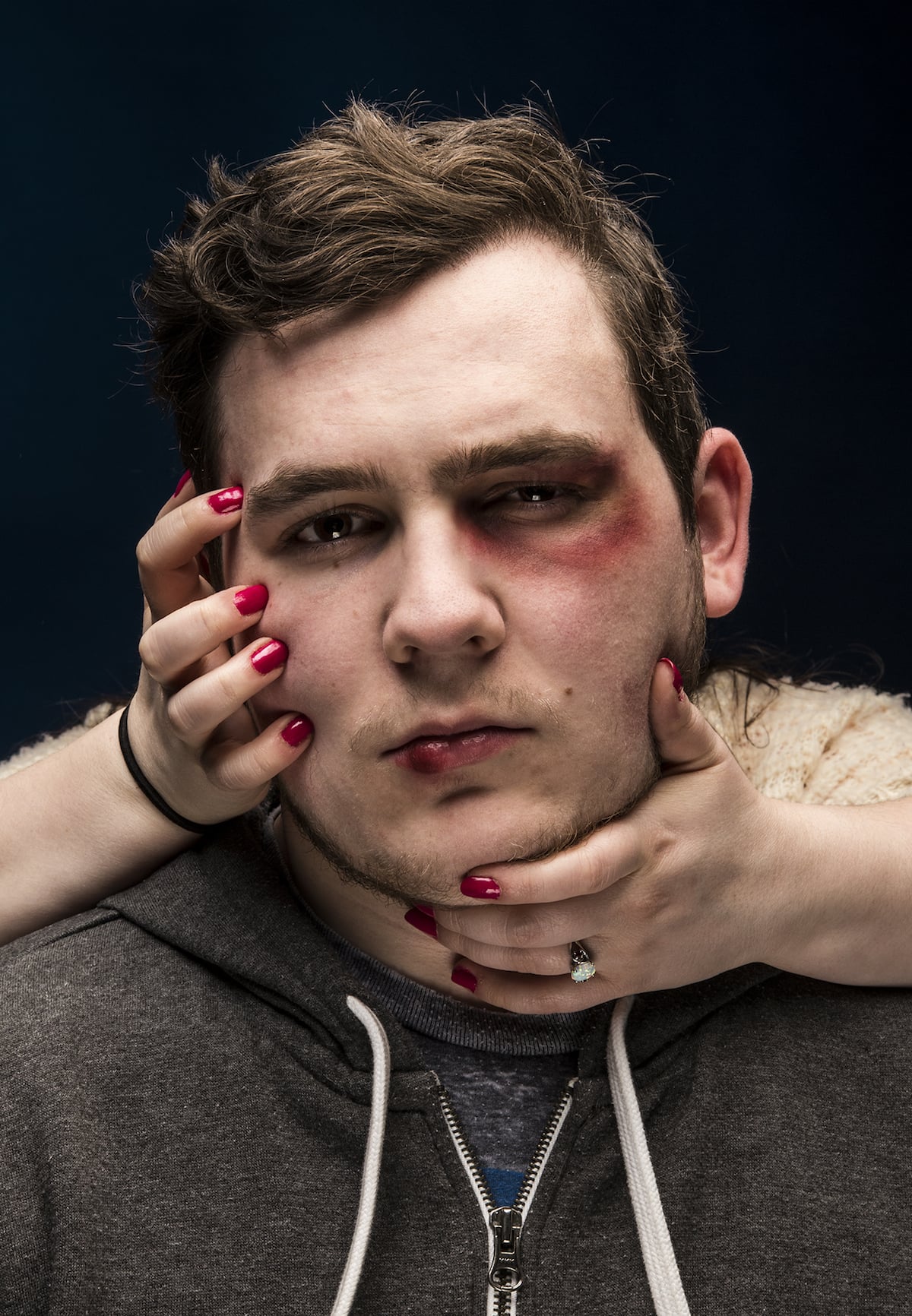
"Be A Man" by Lindsey McGann
There are many problems created by the gender roles society throws upon us. The ones that most people think of first are those imposed on women. But, these stereotypes hurt men as well. The common phrases “be a man” and “man up” show the issue I wanted to portray in this image, that men need to show strength at all times and show no sign of weakness. Showing pain as a male in our culture means that you are weak and “girly,” while as a female it is almost to be expected. It is also taboo for men to hit women. The opposite is the case for women hitting men. The first is often considered abuse, while the later causes less controversy. When a man is slapped by a women people often think he must have “done something wrong.” The reality is that violence is violence, whether the victim is a man or a woman. It should be just as appalling to see a man hit by a woman as it is to see the opposite. To show how wrong this mindset is, even though we consider it a social norm, I wanted to have a man with bruises on his face, while a woman’s hands with feminine pink nail polish was clawing at his face from behind. This represents the theme of harmful gender stereotypes by showing a topic that is often not given as much press as that of opposite gender. This topic is men being the victim of domestic violence. To add to the portrayal of how wrong this idea is, the man has the facial expression of fatigue, indifference and a small glimmer of pride. What his expression does not include is fear, sadness, or pain, feelings any human should express in this situation. His lack of concern for his safety show us that our unequal expectations for how the two genders should react are truly bizarre and it dares us to think differently.

"Your New Beauty Idol" by Lindsey McGann
We see it everywhere. Magazines shouting out that they have the secrets to becoming thinner, tanner, healthier, “more beautiful!” They offer tricks on fixing your makeup, hair or clothes in order to be perceived as “prettier,” or at least prettier by cliche standards. I’ve noticed recently that all of these secrets magazines are claiming they hold tend to be overused, and not secrets at all. The models in the magazines are just as redundant as the tricks they advertise. Page after page the same body type, photoshopped skin, and heavily made up face stares back at the reader, making it seem like this perfect person is the new average. Not only is this standard harmful to those who are unable to achieve it, it also gets monotonous and boring, especially in an era where people are beginning to question the narrow mindedness of the fashion world. This unachievable standard is what people try to measure up to on a daily basis. When they are unable to succeed, they become insecure, deciding they must be “less than average”. This can have extremely harmful effects on their self worth, and who they see themselves as, as well as on their health if they decide to try more extreme measures. To show this dilemma I made the image by using advertisements from different publications to make up one model. The technique shows how similar all the magazines really are. I wanted it to look thrown together, tattered and ripped, in order to give the feel that it was created, as is the ideal beauty standards. The “body parts” look haphazardly placed, and disproportionate, as they are not supposed to be the same image. This represents the fact that the photos we have become so accustomed to seeing are not normal as we perceive them to be, but highly edited and often unattainable.

"Phonecuffs" by Kevin Fitzmaurice
Two of the photos that inspired “Phonecuffs” from TRIIIBE: same difference are “McIntosh” and “MySpace”. They convey the idea that we are so connected to a fake world made up where everyone knows your name, and favorites/likes are badges you wear with pride. We are connected to this world through our cellphones which we are “handcuffed” to. The best part about social media and our cellphones is our identity. We can be whoever we want, through photos, the way we talk, and the things we like. No one has to know who you really are and you can create a person everyone loves. We post only the photos where we appear more attractive and edit selfies so we can accept the way we look. Appearing to be the most attractive on Instagram so people will communicate with you more frequently is absurd. This idea of “catfishing” and false identities as the perfect human has us hiding who we really are and creating superficial profiles. Due to the fact we engage in this fake persona and changed identity gives some people a sense of happiness making it impossible to put their phones down.
This generation has become technology. The generation barrier is a rather large one. Rather than needing cell phones and social media, past generations wrote letters and used face to face interactions to create memories. Now the best way of keeping up with someone is a text or favoriting a tweet.
We shelter ourselves from what is in front of us in the real world, and block ourselves out instead of enjoying a face to face interaction by looking at a bright screen. Half of the time we are on our phones it is spent doing absolutely nothing, like checking twitter or a snapchat story; we are seldom doing anything productive as we disconnect ourselves from the outside world. We as a society are so dependent on our phones. In class we are snapchatting instead of learning. We would risk our lives behind the wheel just to respond to a text. We are surrounded by a world we will never actually see because our heads are always down.

"What makes a woMAN?" by Erin Murphy
There are huge controversies in this world still about gender, and identity. I wanted to touch upon this because it is such a huge part of my life, but also a huge part of TRIIIBE: same difference. Every time I go out in public, I always get stares, as well as comments from strangers off the street. Some are sometimes good, but a lot of the time people are disgusted, just by the way that I look. Yes, I am a woman, but the way that I dress should not have to define that in any way shape or form. I wear men's clothing because it is what I feel most comfortable in; it is a way for me to express who I am without having to discuss it with anyone. I am who I am, and the way that I dress is just a part of me, as is my gender. Clothing is a means of expression amongst your personal identity, and I wear my clothes proudly.
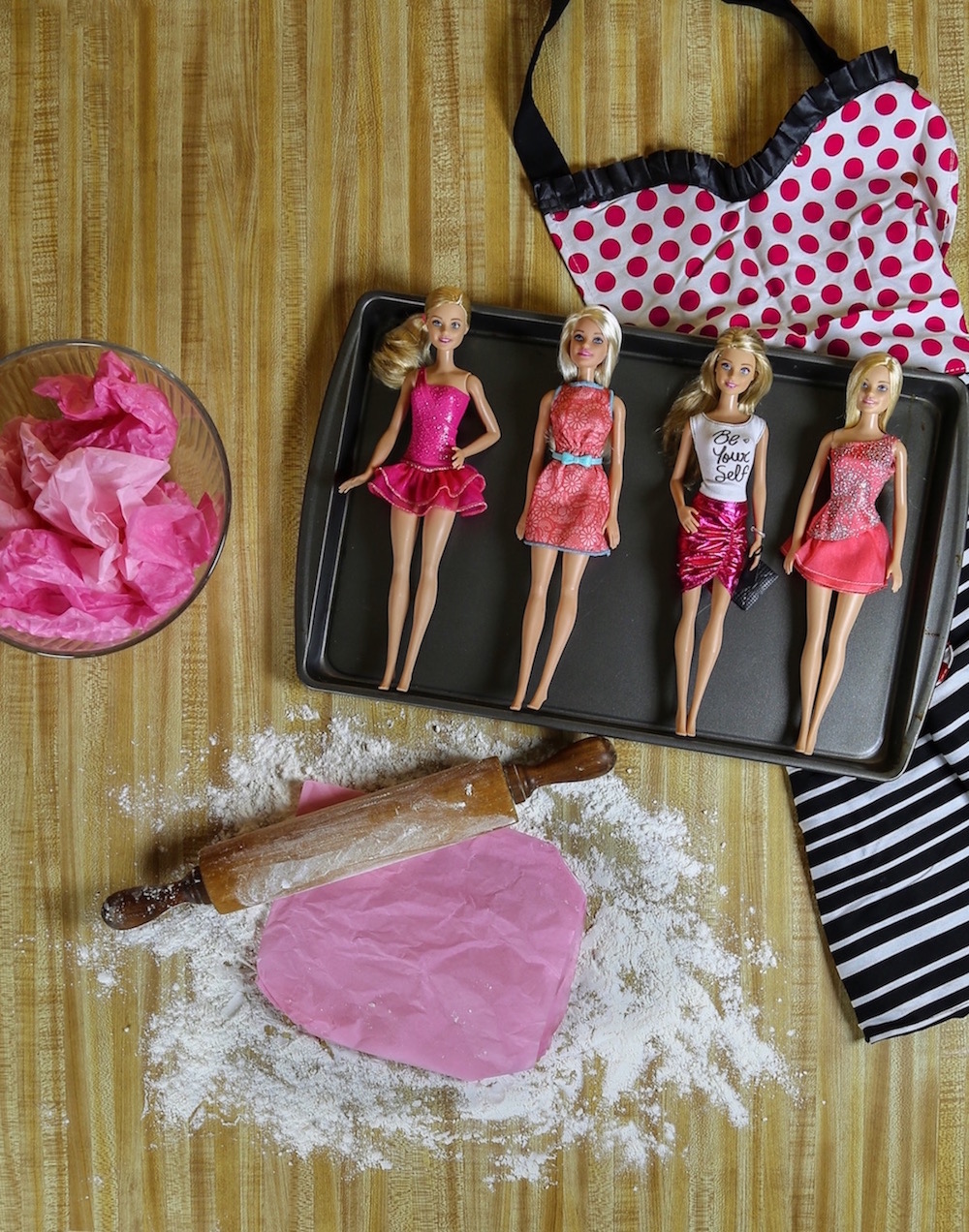
"Cookie Cutter" by Lindsey McGann
In this image, I wanted to portray the beauty standards media and tradition have placed upon the shoulders of women. Our whole lives we have grown up with toys, symbols, and images that tell us we should look unhealthy and disproportionate, and that we need to fill gender roles, such as cooking. These kinds of stereotypes leave no room for individuality. The barbie wearing a shirt that says “be yourself” is in stark contrast of her likeness to the others, driving home this idea. Instead of being “ourselves” we are left trying to fit molds to become copies of the tall thin blonde “Barbie Girl” we idolized as children. I used the play on words “cookie cutter” to represent this in the setting of a kitchen.
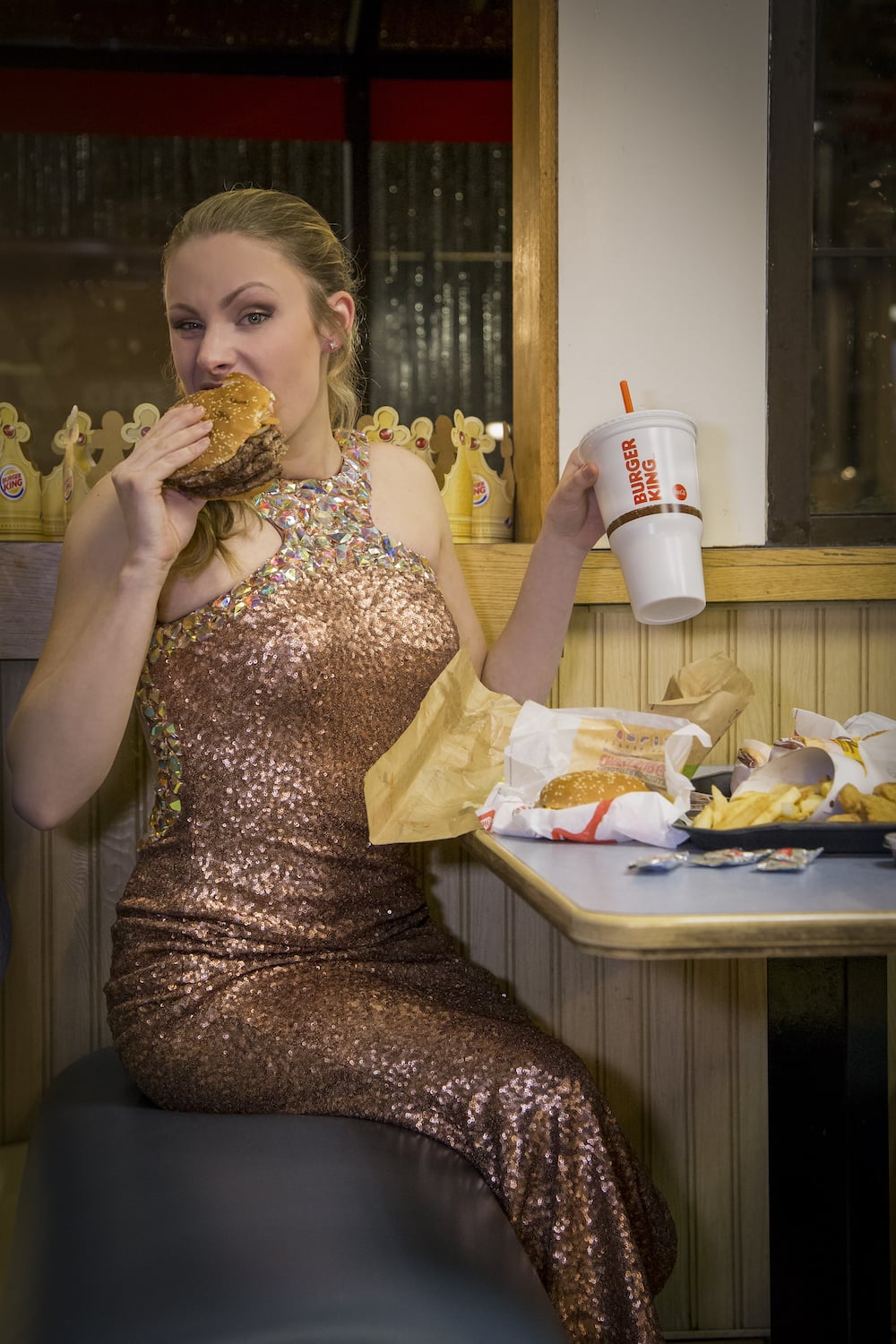
“Miss Imperfection” by Haylie Hier
In this photo, I had the idea of portraying a girl who works so hard to achieve perfection. She’s wearing a sparkly elegant dress with her makeup done perfect all while chowing down on a copious amount of fast food. It doesn’t look right, does it? In my eyes, us girls are exposed to materialistic things and we all strive to be the perfect barbie doll that we all see on T.V. or in magazines…but in the end we realize that image we see everywhere isn’t reality... we’re only human and humans are far from being perfect.

"Hands Tied" by Sara Prunier
This image calls upon the topic of beauty standards in today’s society. The measuring tape around the wrists suggests that as a society our hands are tied. We are constrained by the false concepts of what is beautiful, how we should wear our hair, what clothes we should wear, and what size we should be. If we don’t fit these standards we are in some way lesser, which creates pressure to be perfect. We struggle to obtain this perfect image but in reality it doesn’t exist. We only hope to break these ties and start accepting others for who they are instead of scrutinizing and passing judgment on appearance.
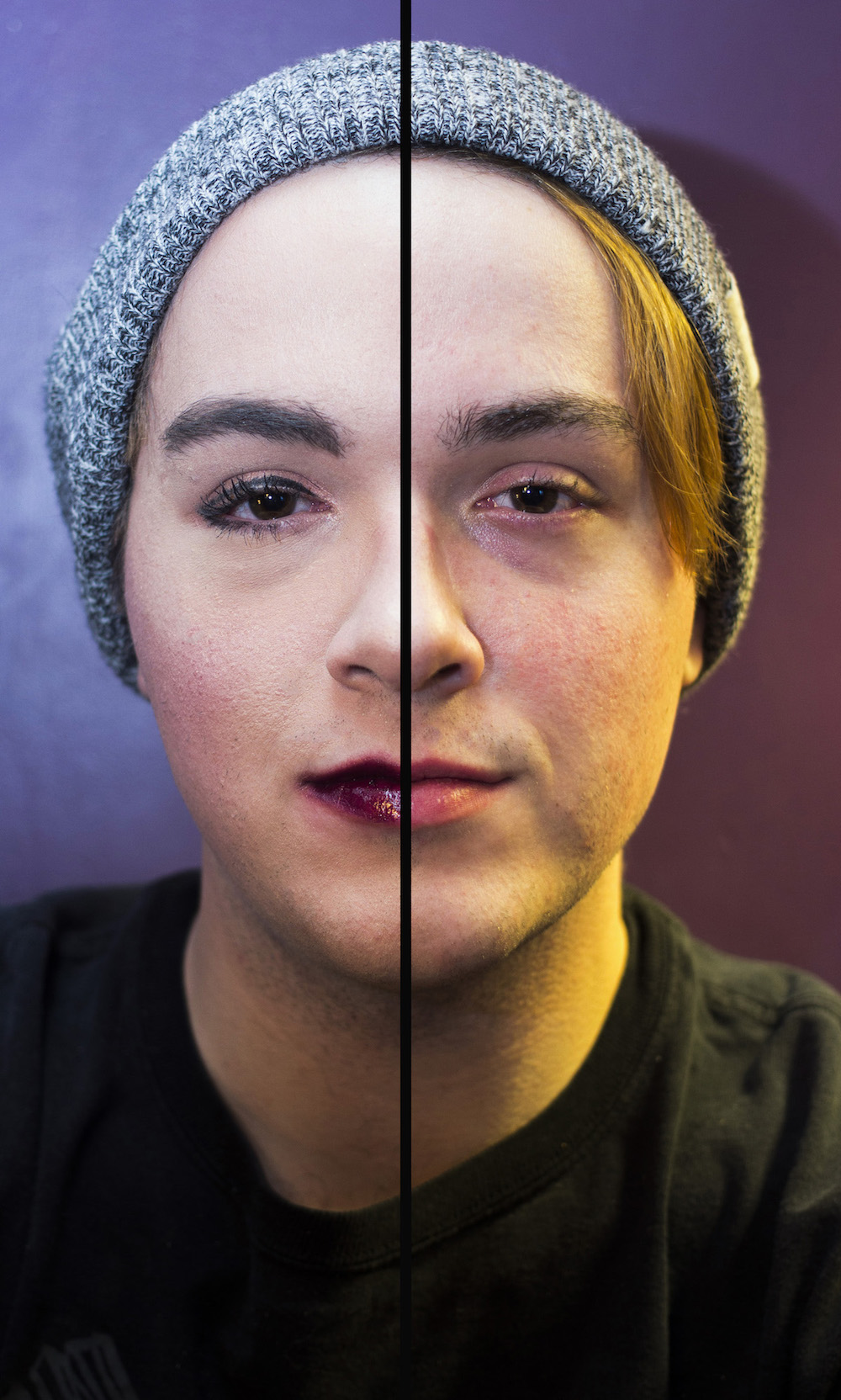
"Magic's In The Makeup" by Erin Murphy
In this day and age many individuals wear makeup. However, some may use it as different means than others. Some may wear it to boost their self esteem, or enhance their look, and others may use it to mask their true identity, or change what they really look like. I chose to create an image that shows one side of the story, masking your true identity. I decided to have my model put makeup on half of his face, and then I drew a line down straight down the middle to show the side with and without makeup on. If you cover up half of the image you can tell that he looks like a different person overall. Makeup isn’t always something that you need to wear, and you should find a way to wear as little as possible if not any to show the world who you really are. Looks aren’t always important, feel comfortable in your own skin, and show the world the real you.
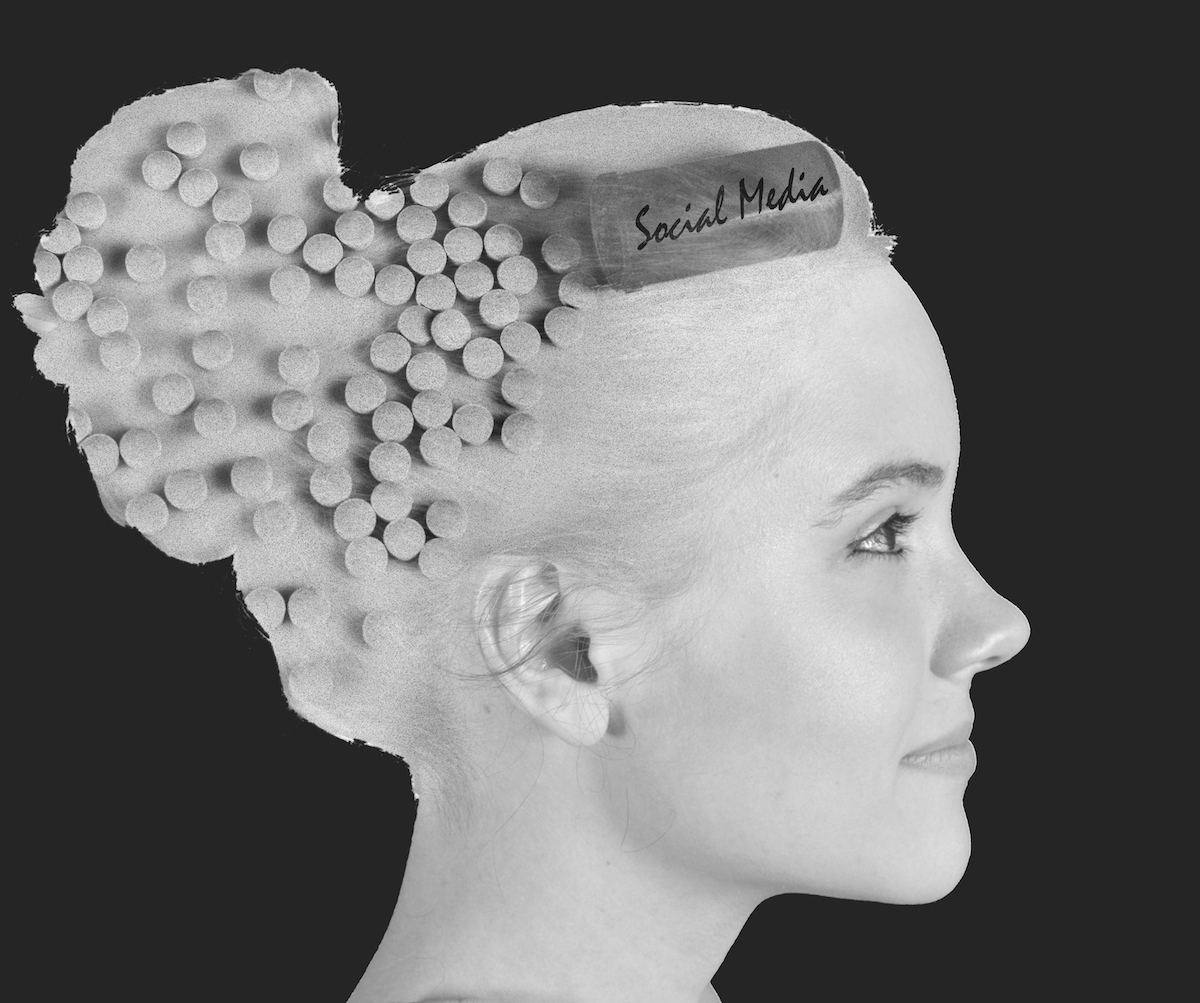
by Sara Prunier
The most obvious interpretation of this image is that the use of social media in today’s society has almost reached the point of addiction. We have become so obsessed with the opinions of others and the immediacy of information that we are slowly being taken over by social media. The image depicts social media as a prescription drug; The intended function of this is, just like the use of prescription drugs, that social media’s pay off depends on the individual's use of it. Prescribed medication is intended to benefit an individual and doesn’t always have to include the negative connotation of drug use. I believe that social media falls into a shade of grey. Yes, some people may overuse it, but others depend on social media for many things. It's a tool that allows people to stay connected with others, learn something new at the ease of a button or even create a career using it. Social Media shouldn’t have to come with a warning label to know that too much of a good thing can be bad.

“A Man’s World” by Kelsey Kunigonis
Public breastfeeding should not create the controversy that it does in today’s modern world. Segregating a woman or escorting her off a plane just because she has exposed her breast to feed her child is archaic. My photograph suggests that it is not an issue of breastfeeding but an issue of women versus men. If the roles were reversed and men were able to breastfeed, I believe that it would not be a controversial issue; there would be no “sexual” intent when seeing a man’s chest exposed. Being in the twenty-first century, it is definitely not motherhood breastfeeding in public but a sexual woman exposing herself that causes the controversy.
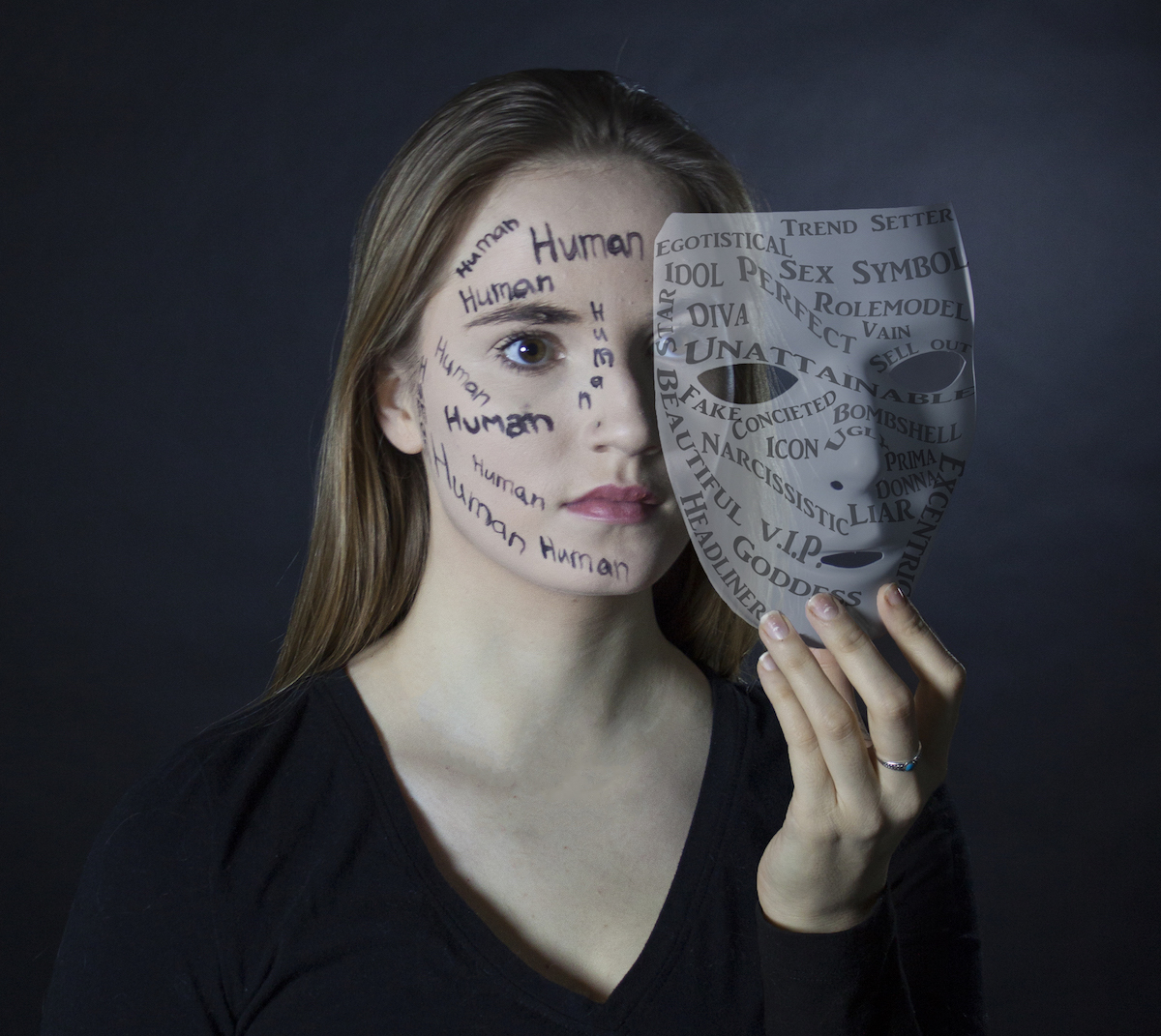
by Lindsey McGann
My image is a composite of photos put together to create a single work. It depicts a woman holding a semi-visible mask made of words. On her own face one word is repeated: "human". This concept can be perceived in two main ways.
One suggests the woman is a public person or celebrity. The mask, holding both good and bad comments, depicts all the collective thoughts of who she is in the eyes of others. Her face mimics this with the word “human”. This represents the ability to be imperfect, make mistakes and be forgiven for all human-like attributes.
The image could also represent the comments sent through social media. People often forget that the words they send behind a computer are going to another person. In this scenario the model represents both the sender and recipient, as media often goes both ways. The mask is the “face” that is given to her by the web, explaining who she is perceived as and who she portrays herself to be.

"We won’t do it" by Haylie Hier
When you take a modern day young woman and make her a 1950’s housewife this is what you get. When you look at old advertisements of women in the fifties, they’re in the kitchen, smiling, making pie and looking perfect. It looks too good to be true, right? My idea was to take a modern day woman and put her in the same situation; as you can tell by her facial expression she isn’t enjoying it. Being a woman in today’s modern era, we all want to conquer the world by presenting ourselves as women did in the 1950’s; cleaning, cooking, taking care of the kids, looking perfect and being the great wife that she should be, all while her husband is at work – but in reality it isn’t all that easy, and sometimes impossible, which is what I wanted my photo to come across as.
